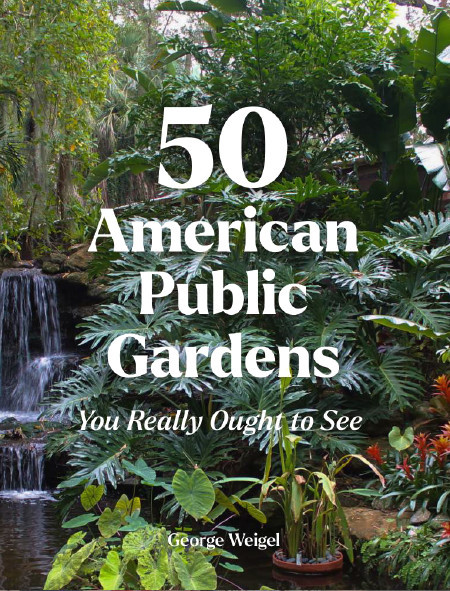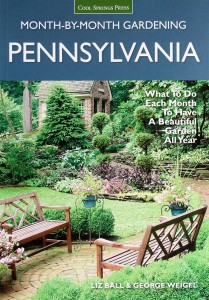Get Those Trees in a Good Spot
April 22nd, 2025
Trees are the most expensive plants in the landscape budget.
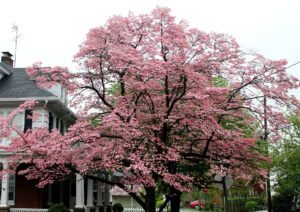
Trees add much to a landscape… if you get the right one in the right spot. This is a pink American dogwood in full bloom.
They not only cost the most at purchase time, but pruning and other care can chew up some dollars over the years. And if you have to have one cut down? Well, let’s not think about that bill.
Picking a tree is a decision you really don’t want to get wrong. It’s not like a $4 potted flower that’s only going to last one season.
The next few weeks are some of the year’s best for adding new trees, which is something we really need for a variety of reasons (shade in our hotter summers, storing carbon, shelter for birds, food for pollinators, beauty for us, etc.)
Unlike picking furniture, you can’t put whatever trees you like wherever you think they’ll look good. Put a tree in an ill-suited spot, and it’ll struggle, refuse to bloom, get diseased and/or croak.
Homework is the answer. So take the time to ponder your choice, and consider the key factors before heading to the nursery.
Illinois’ Morton Arboretum offers these five good pointers on getting the right tree in the right place:
1.) Know your specific sites, especially the kind of light and heat each area gets.
Heat reflected from nearby brick or stone buildings or even a sidewalk or driveway, for example, can make a site hotter than you think.
A site that gets morning sun and afternoon shade is significantly different than a site that gets morning shade and afternoon sun.
Species that aren’t sun- and heat-tolerant will do better in the first scenario, while the second scenario should be treated like a full-sun location.
2.) Pay attention to soil drainage. Clay or compacted soil that doesn’t drain very well is a leading killer of trees.
To test what you have, dig a planting hole, and fill it with water. If the water level hasn’t gone down markedly within two hours, either pick a better drained site or improve the soil with compost over a wide area to create a raised bed to plant in. Or go with a species that’s tolerant of wet soil.
3.) Lean toward trees whose native environment is as similar as possible to your site, i.e. woodland species if you have shade and dampness vs. open-meadow species if your site is full sun and on the dry side.
You’ll make out far better knowing your site and picking a species that’s naturally at home in those conditions as opposed to trying to alter a site to match the conditions of a tree you happen to like.
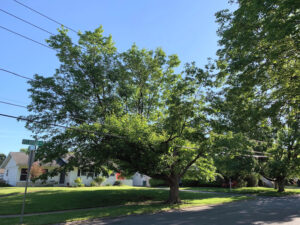
This too-big of a tree under a power line is growing up into the lines.
4.) Give the tree enough space. A leading tree-selection mistake is failing to plan for growth, leading to unnecessary pruning, shortened tree life span, and even property damage, such as pushed-up sidewalks, roots pushing against foundations, and limbs banging into windows or falling onto roofs.
Know how big a tree is going to get in the long run and choose accordingly.
Don’t forget to look up to prevent the too-common problem of trees growing into power lines.
5.) Pay attention to a few seemingly lesser factors that can play big roles in a tree’s success.
No. 1 on that list is how attractive a tree you’re considering is to deer, if you have those four-legged eating machines lurking.
Also consider whether the would-be location gets a lot of salt from sodium-based winter deicers (consider salt tolerance when picking your tree), how acidy the existing soil is (a reading you can get by testing the soil), and whether the site is particularly windy.
I’d add a sixth pointer to Morton’s list: selecting trees that will do well in the climate of the future, not the conditions we’ve had in the past.
Gardeners, urban foresters, and public gardens such as Longwood Gardens and the Chicago Botanic Garden have been documenting that some species are struggling more than others as our climate warms.
Of 50 trees the Chicago Botanic Garden studied, for example, 10 were identified as ones that won’t fare well 30 years from now – American and Greenspire lindens, shagbark hickory, Black Hills spruce, American hop hornbeam, katsura, Norway spruce, Sargent cherry, amur maackia, and Serbian spruce.
The U.S. Forest Service also identified beech, sugar maple, gray birch, eastern white pine, and black cherry as others vulnerable in the climate that’s unfolding.
With all of that in mind, here are some of my favorite species for some different settings to get you started:
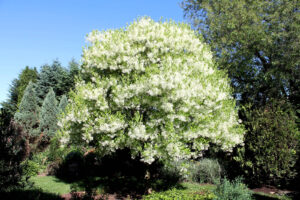
American fringe tree is a good native small flowering tree that blooms white in May.
12 good native trees for Pennsylvania yards: American fringe tree, river birch, blackgum, American dogwood, sweetbay magnolia, serviceberry, red maple, red oak, white oak, American hornbeam, redbud, silverbell, hawthorn ‘Winter King.’
13 small flowering trees (under 25 feet): American dogwood, Kousa dogwood, cornelian cherry dogwood, stewartia, crabapple, American fringe tree, redbud, serviceberry, sweetbay magnolia, seven-son flower, crape myrtle, Japanese tree lilac, witch hazel.
11 good shade trees in the 25- to 50-foot range: hornbeam, blackgum, red maple, Freeman maple, paperbark maple, little-leaf linden, Dutch-elm-disease-resistant American elms (Accolade, Jefferson, Colonial Spirit, Valley Forge, etc.), silverbell, white oak, yellowwood, ginkgo.
10 of the best needled evergreens and conifers: Hinoki cypress, weeping Alaska cedar, green-thread/gold-thread falsecypresses, Oriental spruce, arborvitae ‘Green Giant,’ Japanese umbrella pine, Bosnian pine, eastern red cedar, dawn redwood, bald cypress.
14 trees best suited to take our future heat: American sycamore/London planetree, blackgum, Dutch-elm-disease-resistant elms, Freeman maple, ginkgo, hackberry, Japanese zelkova, Kentucky coffee tree, red maple, red oak, scarlet oak, white oak, sweetgum, yellowwood
See George’s tree-by-tree profiles
Read more on climate-smart trees
Download George’s Survivor Plant List, which includes dozens of tree details





